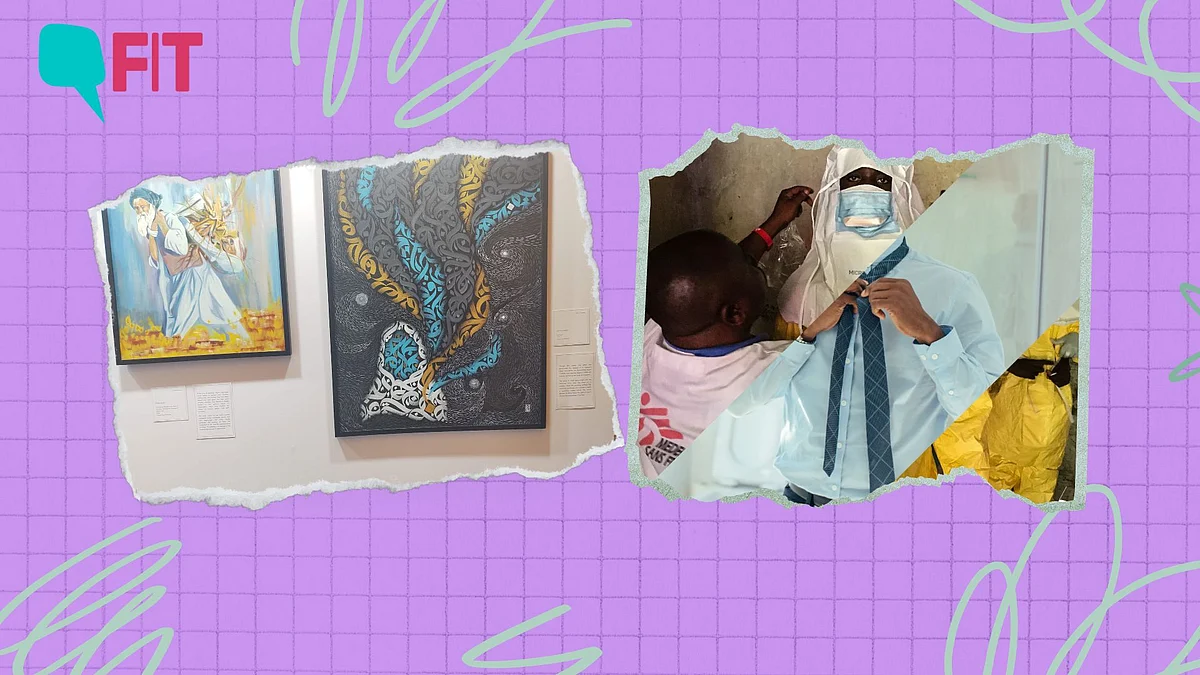Climate Migration to Healthcare Access: Artists Focus on Humanitarian Crises
From climate migration to the chinks in the healthcare system, artists use powerful visuals to speak out.

advertisement
Who gets to have access to lifesaving medicines? Who profits from a pandemic? Why should healthcare be a luxury? Médecins Sans Frontières's Access campaign uses art to put forth these uncomfortable questions.
(Photo: Anoushka Rajesh/FIT)
Displayed at the MSF Health & Humanity Summit in Delhi, on 17 August, the exhibit visually shows how healthcare and medicines are a luxury to many around the globe — equivalent to jewellery studded with precious stones.
(Photo: Anoushka Rajesh/FIT)
"These series, which I created by bringing two photographs side by side, were inspired by the difficulties faced by the wars and conflicts in our world," says Turkish a collage artist, Uğur Gallenkuş.
This piece called 'Dress Code' combines the picture of a healthcare worker at an Ebola treatment center in Congo with that of an officer-goer from another part of the world suiting up for his work day.
(Photo: Shared by the Artist)
"Through the work I have done, I try to create awareness by empathizing with the problems that exist in our world and that people are exposed to. I believe we can minimize these problems if we can empathize," says Uğur.
(Photo: Shared by the Artist)
Abir Abdullah, on the other hand, is a photographer from Bangladesh who has done extensive work on climate change and its impact on indigenous populations.
(Photo: Anoushka Rajesh/FIT)
Abdullah’s powerful photographs shed light on the human consequences of global warming, environmental changes, floods, cyclones, and unpredictable weather patterns.
(Photo: Anoushka Rajesh/FIT)
For artist Danyal Zaheer, art became a medium to channel intense emotions and showcase the turmoil of refugees from his home country of Afghanistan.
(Photo: Anoushka Rajesh/FIT)
"This painting is the story of one Afghan mother who travelled to India as a refugee with her three children. It depicts the feeling of alienation and estrangement they experienced from their homeland," says Danyal.
The central text is a lyric from famous Afghan Singer Ahmed Zahir's song, 'Tanha Shidom Tanha' that translates to 'Now I have become alone.'
(Photo: Anoushka Rajesh/FIT)
Zohra Rezaie was only 15 years old when she came to India as a refugee.
"It was very tough at first because we didn't speak the language, and had trouble getting into school. This is when I taught myself how to paint, and try to use art to inspire a deeper appreciation for the heritage, culture, and courage of Afghan men and women and the contribution they make to the society."
(Photo: Anoushka Rajesh/FIT)
"When you think of Afghanistan, you think of conflict and war, but I wanted to highlight another side of our country," says Zohra.
In this painting, for instance, the woman's outfit made of patches of different clothes depicts resilience, the camel depicts hard work, and the colour green in our culture depicts hope.
(Photo: Anoushka Rajesh/FIT)
Artists from around the world come together at the Médecins Sans Frontières Health and Humanity Summit to bring attention to a slew of humanitarian crises including climate migration, inequitable access to healthcare, and the emotional and physical challenges faced by refugees. Through their art they say they aim to ignite empathy above all.
Here's a glimpse of some of the work on display.